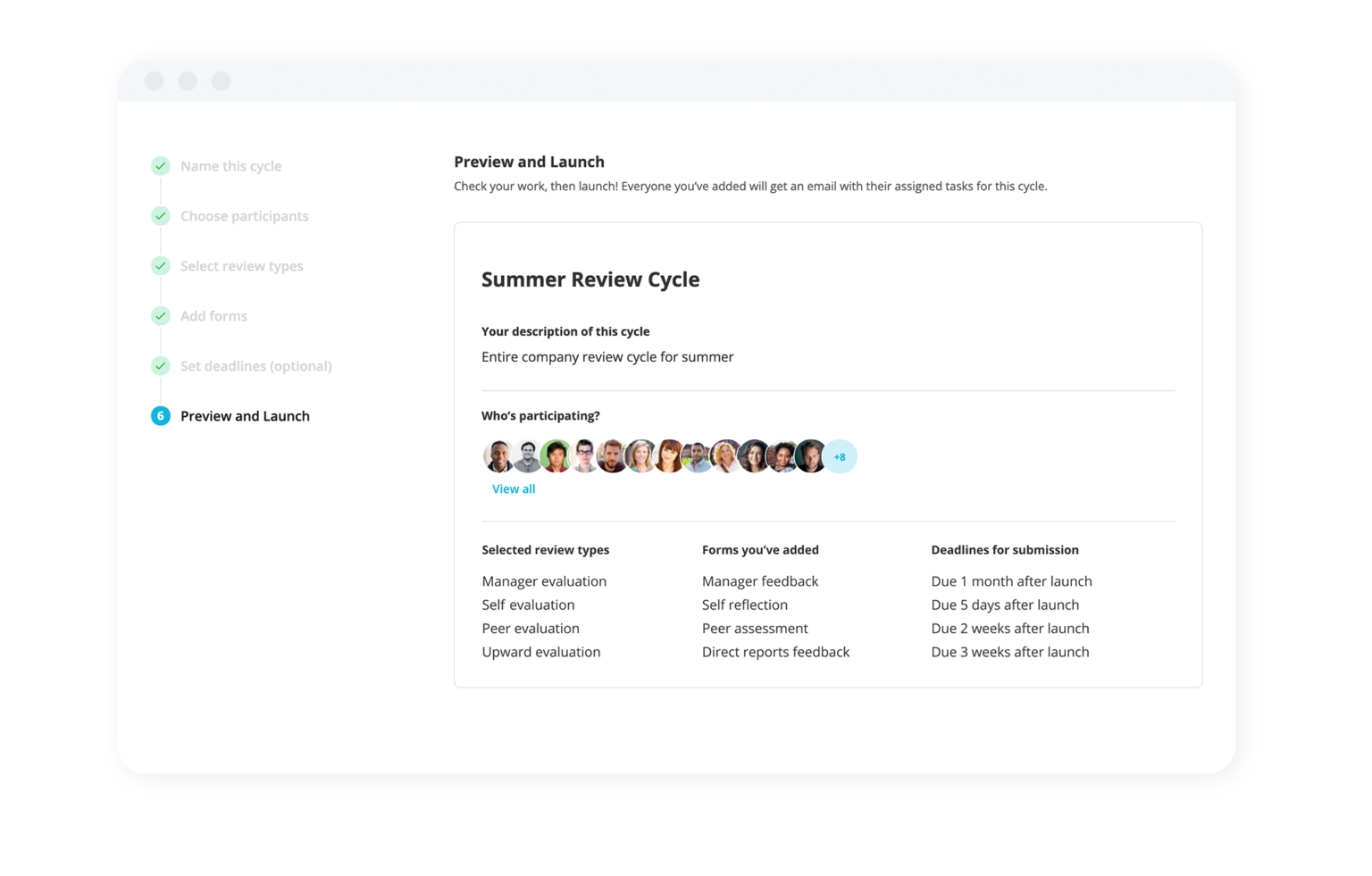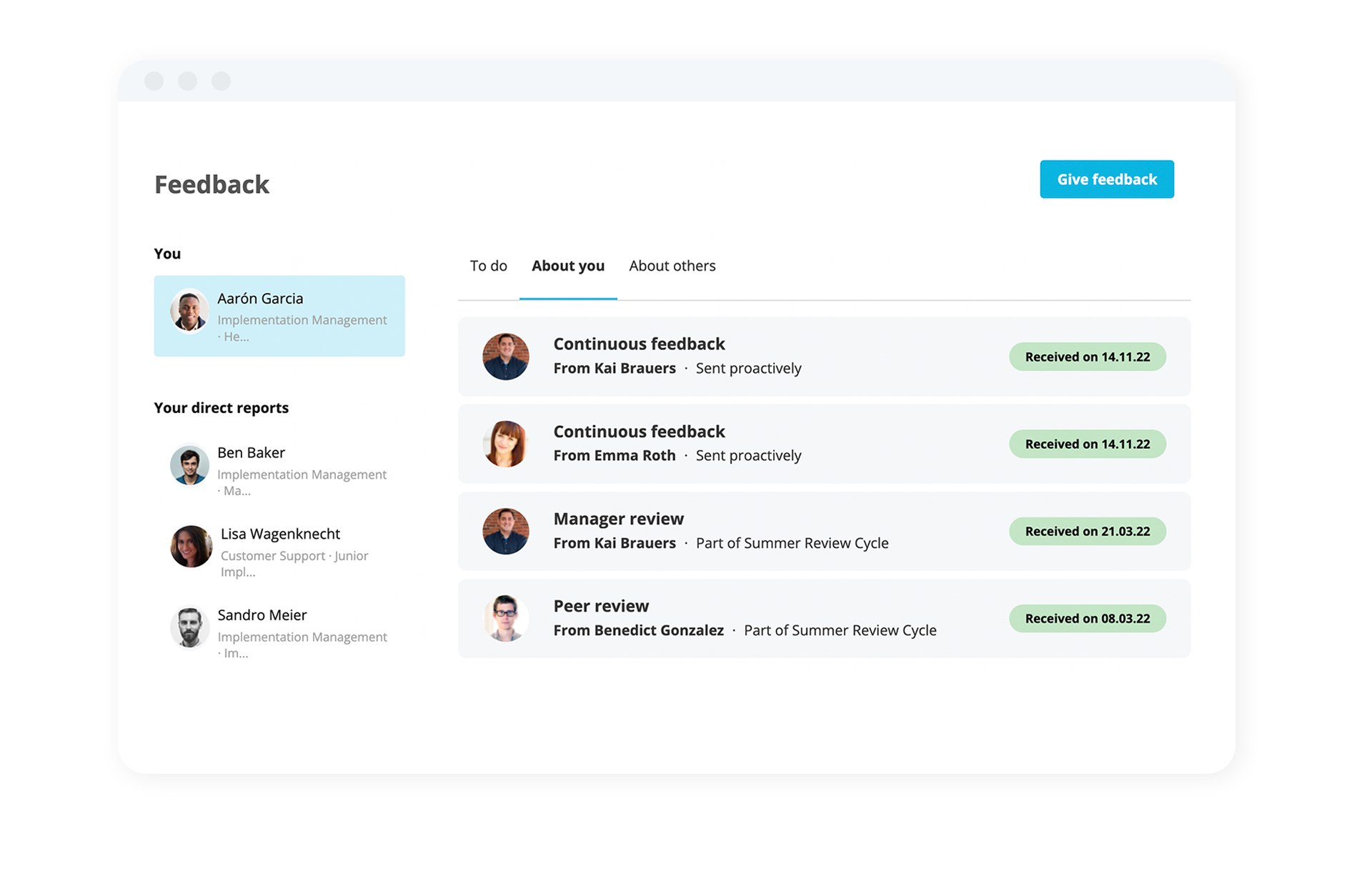How To Conduct a Performance Review: A Guide for Managers
How do you conduct a proper performance review? When done right, these reviews can result in more motivated employees, increased productivity and higher engagement and retention rates. When they’re not, they’re just a big waste of everyone’s time.
That’s why we’ve put together this article with our top tips on running effective performance reviews. By the end of it, you’ll understand how to conduct performance evaluations the right way — and reap the rewards for your organisation.
We’ve split our advice into three key stages: before, during and after your performance review conversations with employees.
Download our free performance review template to dive a bit deeper today.Before the review: Planning and preparation
Performance reviews require a lot of preparation — and this stage is crucial to the success of the entire performance review process. Here are our top tips for getting it right:
Set up a review cycle

Most large organisations already have a preferred process in place for conducting performance evaluations. But it’s always a good idea to consider whether you’re doing things in the most effective way possible.
Traditionally, performance reviews were carried out once a year. But these days, more and more companies are opting for more regular reviews.
Best practice: Carrying out reviews at least twice a year allows you to provide feedback to employees while it’s still relatively fresh for both of you.
Lay the groundwork early
If we could only give one piece of advice to help you run performance reviews effectively, it would be this: nothing that happens during your review meeting should be a surprise to the employee.
At its most basic, this means you should share the timeline for reviews with your employees as soon as you have it in place. That way, they won’t be caught off guard by a performance review they didn’t know was happening, and will have plenty of time to prepare.
You should also clearly communicate the standards you’ll be using to judge performance to your employees, so they know what’s expected of them.
On a practical note, employee performance reviews take a lot of time. Make sure to give each employee the attention they deserve by blocking the time out on your calendar and making it clear to colleagues that you won’t be available.
Prepare feedback beforehand

The most important step in the preparation phase is to reflect on each employee’s performance since their last review. Of course, you might not be able to think of everything off the top of your head. That’s why it’s important to revisit your last performance review, as well as any mid-year check-ins, and notes you’ve made throughout the year.
You should make note of the progress the employee has made towards goals, specific accomplishments they’ve achieved and challenges they’ve encountered. It’s also important to outline any areas where the employee needs to further develop their skills.
Use a performance review template
When every manager handles performance reviews differently, you can end up with unfair, inconsistent results. To avoid this, you should use a performance review template that clearly sets out the elements of your employees’ performance that you’ll be evaluating, and the criteria they’re being judged against.
Even better: When you use a tool like Personio to manage your performance review process, you can set up standardised forms and evaluation scales for use across your organisation. This ensures that all of your performance reviews are fair and consistent, no matter who is conducting them.
Performance Review Template: Host More Productive Conversations

Add more structure to your performance conversations today. Download our templates to help guide the conversation.
Download NowInclude employees in the process
Performance reviews can be anxiety-inducing for employees. And one of the best ways to alleviate that anxiety is to bring them into the process early.
Working together to create a clear agenda for your performance review meeting ensures that employees know what to expect. Instead of them feeling put on the spot during your conversation, you’ll be able to treat it as a positive, constructive discussion.
Best practice: It's a good idea to ask employees to fill out a self-evaluation before their review. This way, they’ll already be reflecting on their performance and what they could do to improve. Employee self-assessments can also provide valuable insights to managers on how employees perceive their own performance — which might differ from your perception.
Gather data from a variety of sources
A good performance review should be objective — not based solely on your opinion as a manager. That means you should try to supplement your own observations with data from different sources.
This might include looking over any recent recognition the employee has received, as well as their self-evaluation. You could also ask for feedback from each employee’s teammates, reports and anyone else they come into regular contact with.
This way of doing things is known as a 360° review, and it can be a useful way of avoiding bias in the review process.
Write the review
The final stage is to write your performance reviews. The most important thing here is to make sure your report is as clear and concise as possible so you don’t confuse your employees. You should also back up your observations with specific examples to help employees understand what you mean.
Lastly, you may want to consider giving your employees a copy of your review before you meet with them. This way, they’ll be able to take the time to review and process what you’ve written, and come to the meeting prepared for a constructive discussion.
During the review: Building a constructive dialogue
Performance conversations can induce a lot of anxiety in employees. Here are our tips for keeping things smooth, positive and constructive:
Communicate clearly and concisely
When you meet with your employees for their performance reviews, your aim is to have a constructive and positive conversation about their work. That means the most important thing is to communicate clearly and effectively.
This is also the time to expand on your observations, perhaps by giving employees concrete examples of what you mean. For example, instead of just saying ‘You have great communication skills’, you might say something like:
‘I think you did a great job running last month’s marketing meeting. Everyone who was involved told me that you clearly communicated your expectations ahead of time. I particularly appreciated how you facilitated communications between the social media and sales teams.’
Another good idea is to tell your employees about the impact of any behaviours you’ve observed — both good and bad. Employees aren’t always 100% clear on how their work connects to the rest of the organisation, so it can be useful for them to think about it within this wider context.
Encourage two-way conversations
A performance review should be an active dialogue between a manager and an employee. That means that you should encourage employees to ask questions and share their thoughts. You should spend a large part of the conversation listening to them instead of just talking.
You can also prompt employees to share their side of things by asking questions like:
What do you hope to achieve in the next year?
What do you expect to be most challenging?
What resources would make your life easier?
How can I better support you as a manager?
What do you see as the next step in your career?
It’s important to remember that these discussions can be tricky for employees. As a manager, your job is to do everything you can to help them feel at ease.
Discuss accomplishments and challenges
It’s a good idea to start your meeting by talking about things that the employee has done well since their last review. Again, you should be specific about accomplishments you have noticed.
Of course, a performance review is also the moment to discuss things that have not gone so well this cycle. You should talk to your employee about any areas where you think they could improve, and ask for their perspective on it too.
It’s important to reflect with your employee on the reasons behind any poor performance, as this could help you to fix the issue going forward. For example, someone who is motivated but lacking in knowledge in a particular area could benefit from targeted training.
Agree on goals and objectives for the future

Although performance reviews inevitably involve talking about the employee’s past behaviours, the focus should be on the future. It should fundamentally be a positive process that’s about working together to help the employee improve.
That means you should work with the employee to come up with a list of goals that you would like them to work towards in time for their next evaluation. If the employee’s performance has been suboptimal in any particular area, you should work together to come up with a plan to tackle this.
After the review: Reflection and follow-up
A performance review isn’t over once you’ve concluded your meeting with the employee. Here are our tips for continuously managing performance, even after performance review season is over:
Provide a copy of the review for the employee
Performance reviews are not a one-and-done situation. It’s important that employees are able to reflect on their reviews after your conversation so that they can make any necessary adjustments to their work.
Providing employees with a copy of their written review, as well as any notes from your conversation, gives them something concrete to look back on over the year. This allows them to regularly review their goals and consider their progress throughout the performance review cycle.
Follow up throughout the year
Even if your organisation hasn’t yet made the switch to more regular performance reviews, it’s still a good idea to schedule a few conversations with each employee throughout the year. This allows you to discuss the progress they’ve made without having to cast your mind back and remember what you discussed a whole year ago.
Some managers also choose to implement an open-door policy, meaning that employees are free to discuss their performance with them at any time. This way, you can make performance a continuous conversation, rather than something you both forget about until review season rolls back around.
Give Potential Room To Grow With Personio

Automate your performance cycles to open up time for job enrichment with Personio today.
Find Out More
Conduct better performance reviews with Personio
Looking for a tool to help you run smooth, efficient and consistent performance reviews at scale? Introducing: Personio.
You can use our platform to set up automated performance cycles for the whole organisation, or just for certain teams or departments. Once these cycles start, managers will be automatically prompted to fill in their reviews and then set up one-on-one meetings with each employee.
Personio also lets you build standardised forms and rating scales, so you can make sure employee evaluations are fair and consistent. And managers can view the distribution of ratings across teams in an easy-to-understand visual format.
Even better: if performance ratings are linked to bonus payments, Personio can automatically transmit this data to payroll — so you can be sure employees will get their well-deserved rewards, with no manual input from managers or HR.
Ready to streamline your performance management process with Personio? Sign up for a free demo to get started.
